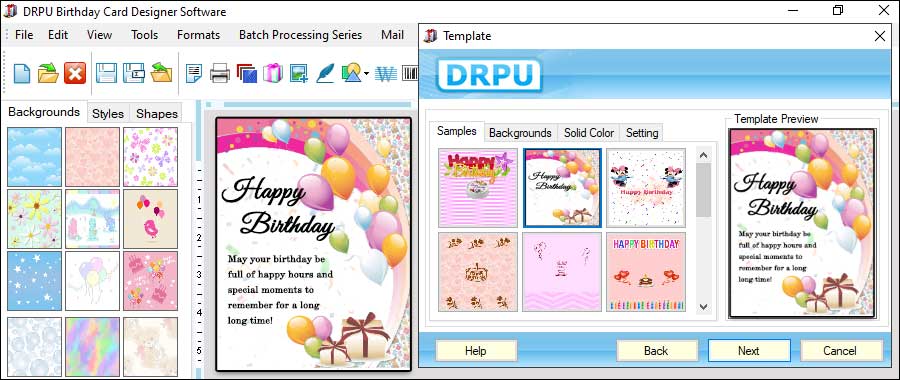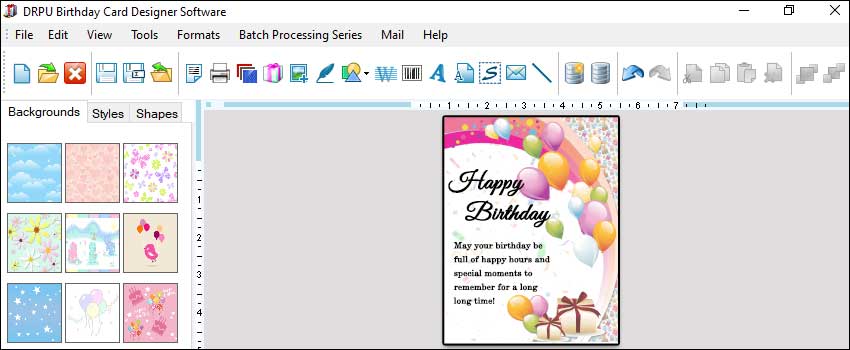Birthday Card Design: Templates, Libraries, Mistakes, and Accessibility
📆 14/07/2023
🕐 8 minutes
Use Templates and Libraries to Speed Up the Design Process
Templates and libraries can be incredibly helpful in streamlining the design process in birthday card designer software. They can save time and effort, while also providing a starting point for creating unique and creative designs. tips to use templates and libraries in birthday card designer software effectively:-

A template is a pre-designed file that includes layout, design elements, and graphics that you can modify and customize to create your own design. Templates are available in different sizes, styles, and themes, such as modern, traditional, and funny. Here are some best practices for using templates in birthday card designer software:
-
Choose the Right Template:
Select a template that suits the occasion, recipient, and style of the birthday card. For instance, if you are designing a card for a child, you might choose a fun and playful template with bright colors and cartoon characters.
-
Customize the Template:
Personalize the template by changing the colors, images, and text to reflect the personality of the recipient and the message you want to convey. Add your own photos, graphics, and fonts to make the design unique and memorable.
-
Maintain Consistency:
While customizing the template, make sure that you maintain consistency in the design elements, such as font size, color scheme, and alignment. Consistency will ensure that the design looks professional and polished.
A library is a collection of design elements, such as graphics, clipart, fonts, and backgrounds, that you can use to create your own design. Libraries are an excellent resource for finding high-quality and unique design elements. Here are some tips for using libraries in birthday card designer software:
-
Organize Your Library: If you have a large library of design elements, it's essential to organize them by category or theme. This will make it easier to find the elements you need quickly.
-
Choose High-Quality Elements: When selecting design elements from the library, choose high-quality graphics and images that are suitable for printing. Low-quality graphics can appear pixelated and blurry when printed, ruining the overall design.
-
Combine Elements: Mix and match elements from the library to create unique and creative designs. For example, you can combine different fonts, graphics, and backgrounds to create a custom design that stands out.
-
Customize Elements: Don't be afraid to modify and customize the design elements to fit your needs. You can change the color, size, and position of the elements to make them work better with your design.
CONCLUSION:Templates and libraries are powerful tools that can help speed up the design process in birthday card designer software. By using these resources effectively, you can create custom and professional-looking designs that are unique and memorable. Remember to choose the right template, customize it to suit your needs, and maintain consistency in the design elements. When using libraries, organize them, choose high-quality elements, and don't be afraid to mix and match to create unique designs.
Make Sure Your Birthday Card Designs are Accessible for All
Designing accessible birthday cards is essential to ensure that everyone can enjoy and share your creations. Accessibility is about making sure that your designs are inclusive and can be accessed by people with different abilities, including those with visual, auditory, or cognitive disabilities. Some best practices to follow when designing birthday cards that are accessible for all users:-

-
Use high-contrast colors:
Using high-contrast colors is essential for ensuring that the text and images in your birthday card designs are easily visible and legible. People with visual impairments or color blindness may have difficulty reading or seeing low-contrast designs, so it is important to choose colors that contrast well with each other.
-
Choose readable fonts:
The font you choose for your birthday card design can have a significant impact on its readability. When selecting a font, make sure it is easy to read and does not have overly decorative elements that could make it difficult for some people to read. Avoid using fonts that are too small, too thin, or too ornate.
-
Provide alternative text for images:
Adding alternative text for images is an essential step for making your birthday card designs accessible. Alternative text, also known as alt text, is a brief description of the image that can be read aloud by screen readers for people with visual impairments. This allows them to understand the image's content and context, even if they cannot see it.
-
Ensure keyboard accessibility:
Keyboard accessibility is an essential component of designing the accessible birthday cards. Some users may not be able to use a mouse or other pointing devices, so it is important to ensure that your birthday card designs can be navigated using the keyboard alone. Make sure that users can easily access all the interactive elements in your designs using only the keyboard.
-
Test your designs with assistive technology:
Testing your birthday card designs with assistive technology can help you identify accessibility issues. Screen readers, magnifiers, and other assistive technologies can help you see your designs from the perspective of someone with a disability. This will help you identify any issues and make the necessary changes to make your design accessible.
-
Avoid using flashing or animated content:
Flashing or animated content can be problematic for people with epilepsy, as it can trigger seizures. To avoid this, it is best to avoid using flashing or rapidly changing content in your birthday card designs.
-
Use descriptive link text:
When adding links to your birthday card designs, it is important to use descriptive link text that provides users with an idea of what to expect when they click on the link. This can help people with visual impairments or cognitive disabilities to navigate your designs more easily.
In conclusion, designing accessible birthday cards is essential to ensure that everyone can enjoy and share your creations. By following these best practices, you can create designs that are inclusive and accessible to people with different abilities.